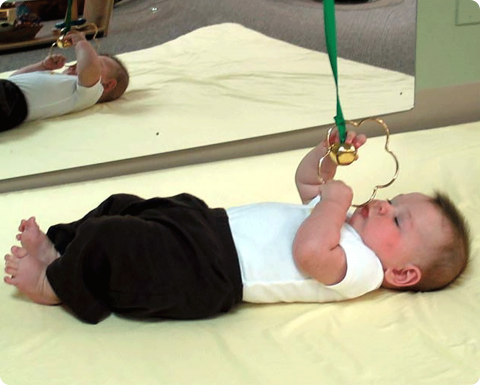Reading Your Baby's Cues
Young babies have very clear Behavioural States because of the immaturity of their central nervous systems. Knowing about these states and how babies make the transition from one to the next, can help you tune into your baby’s daily rhythm. Tuning into your baby will increase your levels of satisfaction in the early weeks. You will have a sense of what is coming next and how to respond to your baby's needs before they arise.
Quiet Alert
The best time to interact with or feed your baby is when they are in a Quiet Alert state. In this Behavioural State, your baby’s body will be relaxed and still. This is when they are most attentive to stimuli and are able to interact with you. They can be quietly focused in their attention just like the baby in the picture. If you are close enough they will watch your face intently, giving themselves little breaks and then refocusing.
Active Alert
As your baby becomes tired, they will start to transition to an Active Alert state. You will notice a change in their behaviour. Their body will become more tense. They might clench their fists, arch their backs and make jerky movements with their arms and legs. Your baby will no longer want to meet your gaze and might frown or yawn. They might start to vocalise more, making loud vowel sounds or grizzling noises. A single cue of this type may not indicate tiredness, but when you see clusters of these cues it is time to act. Your baby is getting tired. You might respond by:
- Becoming quiet yourself
- Letting your baby be still, very young babies need help with this and providing loose wrapping can help;
- Reducing the light around your baby;
- Providing close body contact, or placing your baby in their safe sleep space.
Crying
If you are unable to change what is happening around your baby at this point (maybe you’re in the car or visiting friends) they may begin to cry. They have basically reached their limit. Crying does not always mean that your baby is tired. It is their most effective way of letting you know that they have an unmet need. That need could be that they just need a change, a feed, they might be too hot or too cold, or uncomfortable in their nappy. But if you are aware of where your baby is in their cycle of Behavioural States, you will be better able to determine the nature of their need. When a young baby becomes over-tired, they will need to more physical support, in order to transition into a sleep state.
Quiet Sleep
This is a deep sleep state. We are familiar with this sleep state as adults. Your baby’s body will be still, their eyes closed tight, their faces relaxed. You might see bursts of sucking movements. If you try to wake your baby from this state to feed them, they will go back to sleep almost immediately. Young babies have deep sleep cycles of around 45 minutes before coming into a light or Active Sleep.
Active Sleep
In Active Sleep, your baby might move around more. They might make facial movements, and even smile! Their eyes might move under the lids. They are in REM (Rapid Eye Movement) sleep. It is much easier to wake your baby in this state. Your baby might be more responsive in an active sleep state, but feeding will probably still be difficult. Depending upon how tired they are and what is happening in around them, your baby may wake up fully, or go back to into Quiet Sleep.
Drowsy
As your baby wakes up, they move into a Drowsy state. This is a transitional phase between a sleep state and an awake state. They may open and then close their eyes again. You might see the thousand yard stare. It can be hard to tell if they are actually awake or still asleep. In fact, both are possible at this point! It is easier to wake a young baby in a drowsy state, but it will still be difficult to feed them until they are fully awake and have returned to a Quiet Alert state.

